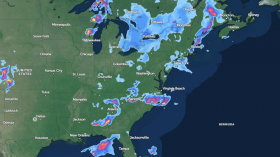Marine heat waves are events or periods of unusually high ocean temperatures, resulting in ocean warming or acidification that threatens marine animals, plants, and their habitats. Similar to Earth's oceans, terrestrial environments or mainland regions in different continents globally also experience heat waves. This phenomenon on land affects not only agriculture and wildlife but also human society.
Since there are different types of heat waves, one in particular has caught the attention of marine scientists. Dubbed "warm blobs" or "Pacific blobs," these warm patches in the middle of the Pacific Ocean have been reported over the past decade. Particularly, these blobs pertain to a large area of water that is significantly warmer than average, affecting marine life and regional ecosystems.
According to an April 2024 study, the Northeast Pacific warm blobs are sustained or fueled by planetary heat waves via extratropical atmospheric teleconnections. The international team of researchers, including from China, France, and Australia, involved in the study state the driver behind these Pacific blobs causes unusually cold temperatures over North America during the cold season.
Marine Heat Waves
![Marine Heat Waves: Deadly 'Warm Blobs' in the Pacific Fueled by Planetary Wave Trains [Study] Marine Heat Waves: Deadly 'Warm Blobs' in the Pacific Fueled by Planetary Wave Trains [Study]](https://1471793142.rsc.cdn77.org/data/images/full/70443/marine-heat-waves-deadly-warm-blobs-in-the-pacific-fueled-by-planetary-wave-trains-study.jpg?w=820)
(Photo : Photo by Austin Schmid on Unsplash)
The natural phenomenon of ocean warming caused by heat waves has often been linked with climate change and global warming. Over the past decade, marine heat waves or "MHWs" have increased by 50%, are currently longer, and more severe. MHWs have a duration of several weeks or even years, the International Union for Conservation of Nature (IUCN) says.
This extreme ocean warming event can result in the shifting of marine species population, lead to mass mortality incidents, and spread of harmful algal blooms. Since 1982, the number of marine heat wave events has doubled, including in the Pacific Ocean. Over the last century, the total number of days with MHWs averaged globally has also increased by 50%, the IUCN reported.
Also Read: Marine Heat Waves: New Zealand's Hauraki Gulf Region Experiences Extreme Temperatures Since 1967
Northeast Pacific Warm Blobs
In the study published in the journal Nature Communications in April 2024, an international research team determined that large-scale marine heatwaves in the Northeast Pacific Ocean, identified as warm blobs, is destroying regional ecosystems. The researchers pointed out these Pacific blobs are being sustained by an anomalous atmospheric ridge over the Northeast Pacific.
As mentioned earlier, the team (along with previous studies) has linked this ridge to atmospheric teleconnections from tropical sea surface temperature anomalies. However, the April 2024 research paper clarified that it remains unclear whether or not teleconnections from the extratropics could contribute to the ridge. With this, the authors of the paper found a novel approach to this dilemma.
Planetary Train Waves
Based on their findings, the researchers found that planetary wave trains can transport wave energy to the Northeast Pacific Ocean, guided by a westerly jet. This is made possible after these waves are activated by amplified rainfall and heat release over the Mediterranean Sea. The event also occurs along with reduced rainfall over the North Atlantic Ocean, according to the study.
Planetary wave trains, also called Rossby waves, naturally occur in rotating fluids. This phenomenon happens within the Earth's oceans and atmosphere as a result of the rotation of our planet, according to the National Oceanic and Atmospheric Administration (NOAA). Rossby waves are known for helping in the transfer of heat from the tropical region to the poles and cold air vice-versa.
Related Article: Scientists Blame Marine Heat Waves for Alarming Squid Bloom in US Pacific Coast
© 2024 NatureWorldNews.com All rights reserved. Do not reproduce without permission.





